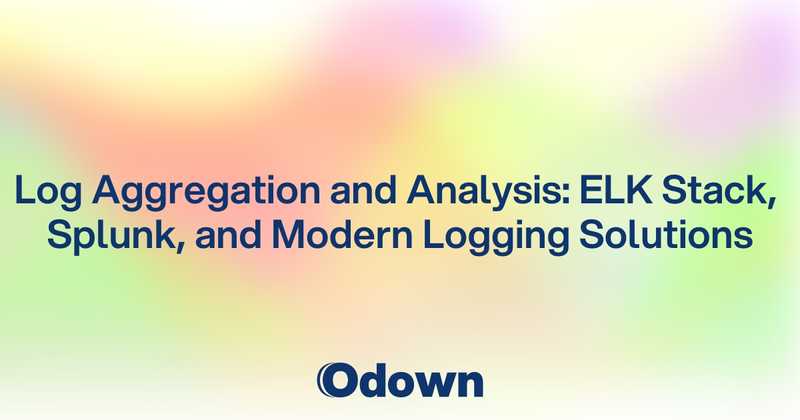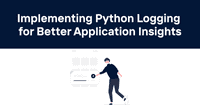Log Aggregation and Analysis: ELK Stack, Splunk, and Modern Logging Solutions
Your application just crashed, and you're frantically SSH-ing into dozens of servers trying to piece together what happened. Log files are scattered across different machines, in different formats, with different timestamps. By the time you find the relevant entries, your users have already moved on to a competitor.
This scenario repeats itself in organizations worldwide because they treat logs as an afterthought rather than a critical operational asset. Modern applications generate massive amounts of log data, but without proper aggregation and analysis, this data becomes a liability rather than an asset.
Log aggregation transforms scattered, unstructured log data into actionable insights that help you prevent problems, optimize performance, and respond to incidents faster. But building effective log aggregation requires understanding collection strategies, analysis techniques, and the tools that make sense of the chaos.
Modern monitoring platforms integrate log aggregation with performance monitoring to provide complete visibility into application behavior. But effective log analysis goes beyond simple collection---it requires strategic thinking about what to log, how to process it, and how to extract value from the data.
Log Aggregation Architecture: Collection, Processing, and Storage Strategies
Building effective log aggregation requires architectural decisions that balance performance, cost, and analytical capabilities. The wrong architecture choices can make log analysis expensive and slow, while the right choices enable powerful insights.
Collection Strategy Design
Log collection seems straightforward until you consider the scale and variety of modern applications:
Agent-based collection provides reliable log forwarding but requires deploying and managing agents across your infrastructure. Log agents like Filebeat, Fluentd, or the Elastic Agent can handle log parsing, filtering, and reliable delivery to central systems.
Agentless collection reduces operational overhead but might miss logs when network connectivity fails. Syslog forwarding and cloud-native log streaming work well for many applications but don't provide the same reliability guarantees as agent-based approaches.
Hybrid collection strategies combine multiple approaches based on criticality and operational requirements. Critical application logs might use reliable agent-based collection while infrastructure logs use simpler syslog forwarding.
Processing Pipeline Architecture
Raw logs are rarely ready for analysis and need processing to extract maximum value:
Real-time processing enables immediate alerting and response but requires more complex infrastructure. Stream processing platforms like Apache Kafka or Amazon Kinesis can handle high-volume log streams with low latency.
Batch processing provides cost-effective analysis for historical data and complex analytics. Batch processing works well for trend analysis, compliance reporting, and other use cases that don't require immediate results.
Multi-stage processing pipelines handle different types of analysis at different speeds. Initial parsing and alerting happen in real-time, while complex correlation analysis and machine learning happen in batch processing jobs.
Storage Architecture Optimization
Log storage costs can quickly spiral out of control without proper architecture planning:
Hot-warm-cold storage strategies optimize costs by moving older logs to cheaper storage tiers. Recent logs need fast access for troubleshooting, while historical logs can use slower, cheaper storage for compliance and trend analysis.
Retention policy automation ensures logs are kept for the right amount of time based on their value and regulatory requirements. Different types of logs have different retention requirements that should be automated to prevent both compliance issues and excessive storage costs.
Compression and indexing strategies balance storage costs with query performance. Heavy compression reduces storage costs but can slow query performance, while extensive indexing improves queries but increases storage requirements.
Log Analysis Techniques: Pattern Recognition and Anomaly Detection
Raw log data becomes valuable through analysis techniques that identify patterns, detect anomalies, and correlate events across different systems and timeframes.
Pattern Recognition and Classification
Most log analysis starts with identifying patterns in seemingly chaotic data:
Regular expression parsing extracts structured data from unstructured log entries. Well-designed regex patterns can turn free-form log messages into structured fields that enable powerful analysis and correlation.
Log classification automatically categorizes log entries based on content, severity, or source. Machine learning models can learn to classify logs more accurately than rule-based systems, especially for applications with complex or changing log formats.
Temporal pattern analysis identifies recurring patterns in log data over time. Daily, weekly, or seasonal patterns in log volume or content can help distinguish normal behavior from anomalies.
Anomaly Detection Methods
Anomaly detection helps identify problems before they become critical incidents:
Statistical anomaly detection uses mathematical models to identify log patterns that deviate significantly from normal behavior. Sudden spikes in error rates, unusual message patterns, or unexpected silence can all indicate problems.
Machine learning-based detection adapts to changing application behavior and can identify subtle anomalies that rule-based systems miss. ML models can learn what normal log patterns look like and alert when patterns change significantly.
Correlation-based detection identifies anomalies by comparing logs from different sources. An increase in database errors combined with network timeouts might indicate a specific type of infrastructure problem.
Log Correlation and Timeline Analysis
Individual log entries tell incomplete stories. Correlation analysis reveals how events relate across different systems:
Cross-system correlation links related events across different applications and infrastructure components. A user login event in your application logs should correlate with authentication events in your security logs and database access patterns.
Request tracing follows individual user requests through multiple systems and services. Distributed tracing helps you understand the complete journey of user requests and identify where problems occur.
Timeline reconstruction builds chronological narratives of incidents or user activities. When investigating problems, understanding the sequence of events across different systems helps identify root causes.
Application Log Monitoring: Error Detection and Performance Correlation
Application logs contain the most detailed information about how your software behaves, but extracting actionable insights requires specific monitoring approaches tailored to application-specific concerns.
Error Detection and Classification
Not all errors are equally important, and effective monitoring distinguishes between different types of problems:
Error severity classification helps prioritize response efforts. Database connection failures are more critical than validation errors, but both should be tracked and analyzed differently.
Error pattern analysis identifies recurring problems that might indicate systemic issues. The same error occurring frequently might indicate a bug, configuration problem, or capacity issue that needs attention.
Error correlation with user impact helps you understand which errors actually affect users versus which are handled gracefully by your application. Errors that users never see might be worth logging but shouldn't trigger the same response as user-facing failures.
Performance Correlation Analysis
Application logs often contain performance-related information that traditional monitoring misses:
Response time correlation links slow user requests with specific code paths, database queries, or external service calls. Log analysis can reveal performance bottlenecks that aren't obvious from high-level metrics.
Resource utilization correlation compares application behavior with infrastructure performance to identify capacity issues or optimization opportunities. High CPU usage during specific application operations might indicate inefficient code.
User experience correlation maps application log events to user experience metrics. Slow database queries might correlate with user abandonment, helping you prioritize performance improvements.
Application Health Trending
Long-term analysis of application logs reveals trends that help with capacity planning and system optimization:
Feature usage analysis tracks how users interact with different parts of your application. This information helps prioritize development efforts and identify features that might need performance optimization.
Error trend analysis identifies whether error rates are improving or degrading over time. Gradual increases in error rates might indicate technical debt, capacity issues, or code quality problems.
Performance trend analysis reveals whether application performance is stable, improving, or degrading. Performance trends help you understand the impact of code changes, infrastructure modifications, or usage pattern changes.
Security Log Analysis: Threat Detection and Incident Investigation
Security logs provide crucial information for detecting threats and investigating incidents, but effective security log analysis requires specialized techniques and tools.
Threat Detection Patterns
Security threats often leave traces in logs that can be detected with proper analysis:
Authentication anomaly detection identifies unusual login patterns that might indicate compromised accounts or brute force attacks. Multiple failed logins from different geographic locations or unusual access times can signal security issues.
Access pattern analysis tracks how users interact with sensitive resources. Unusual data access patterns, privilege escalation attempts, or access to resources outside normal user behavior can indicate insider threats or compromised accounts.
Network communication analysis identifies suspicious connections or data transfers. Connections to known malicious IP addresses, unusual data transfer volumes, or communication with unauthorized external services can indicate security compromises.
Incident Investigation Techniques
When security incidents occur, log analysis provides the evidence needed for investigation and response:
Forensic timeline reconstruction builds detailed chronologies of security incidents using logs from multiple sources. Understanding exactly what happened and when is crucial for containing threats and preventing recurrence.
Attack vector analysis uses log data to understand how attackers gained access and what they accomplished. This information helps strengthen security controls and prevent similar attacks.
Impact assessment analysis determines what data or systems were affected by security incidents. Knowing the scope of a breach is essential for compliance reporting and remediation planning.
Compliance and Audit Support
Many organizations must maintain detailed logs for compliance and audit purposes:
Audit trail generation creates comprehensive records of user activities and system changes. Compliance requirements often specify what events must be logged and how long logs must be retained.
Compliance reporting automation generates required reports from log data. Automated reporting reduces manual work and ensures consistency in compliance documentation.
Data privacy protection ensures that logs contain necessary information for security monitoring without violating privacy regulations. Proper log design balances security needs with privacy requirements.
Effective log analysis requires integration with broader monitoring strategies. Network performance monitoring provides additional context that helps correlate network events with application logs.
Ready to implement comprehensive log aggregation and analysis? Use Odown and build the log monitoring capabilities your organization needs to maintain security, optimize performance, and respond effectively to incidents.



